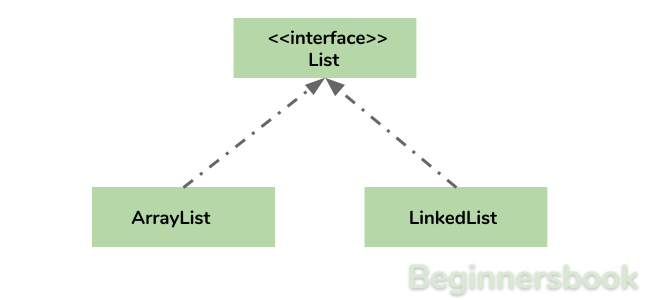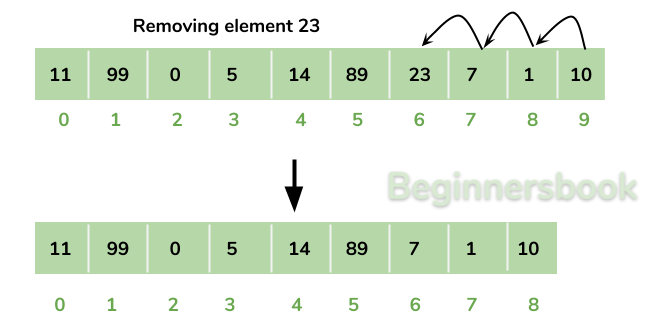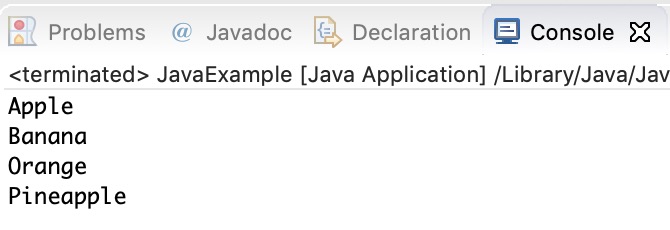Read File of Names Addresses and Assign to Type Person Arraylist
Arraylist class implements List interface and it is based on an Assortment information construction. It is widely used because of the functionality and flexibility it offers. Most of the developers choose Arraylist over Array as information technology's a very good alternative of traditional java arrays. ArrayList is a resizable-assortment implementation of theList interface. Information technology implements all optional listing operations, and permits all elements, includingnull.

Table of Contents
1. Why ArrayList better than Array?
2. Create ArrayList
3. Add together element
4. Change an element
5. Remove element
6. Loop ArrayList
7. ArrayList size
viii. A simple example of ArrayList
9. Sort ArrayList
10. Methods of ArrayList class
eleven. Links of l+ Tutorials and examples published on this website
Why ArrayList is meliorate than Array?
The limitation with array is that it has a stock-still length and then if it is full y'all cannot add whatsoever more elements to it, likewise if in that location are number of elements gets removed from it the retentivity consumption would be the same as it doesn't compress.
On the other ArrayList tin dynamically grow and shrink after addition and removal of elements (Come across the images below). Apart from these benefits ArrayList class enables united states of america to use predefined methods of it which makes our task piece of cake. Let's see the diagrams to understand the improver and removal of elements from ArrayList and and then we will run into the programs.
Calculation Element in ArrayList at specified position:

Removing Element from ArrayList:

At that place is a list of several tutorials on ArrayList at the end of this guide, refer information technology to understand and learn ArrayList concept fully.
How to create an ArrayList?
We can create an ArrayList by writing a simple statement like this:
This statement creates an ArrayList with the name alist with type "Cord". The blazon determines which blazon of elements the listing will have. Since this list is of "Cord" type, the elements that are going to be added to this list volition exist of type "String".
ArrayList<String> alist=new ArrayList<Cord>();
Similarly we can create ArrayList that accepts int elements.
ArrayList<Integer> list=new ArrayList<Integer>();
How to add elements to an ArrayList?
Nosotros add together elements to an ArrayList by using add together() method, this method has couple of variations, which nosotros can use based on the requirement. For instance: If we desire to add the element at the stop of the List then simply do it like this:
alist.add("Steve"); //This volition add "Steve" at the terminate of List To add together the element at the specified location in ArrayList, we can specify the index in the add method like this:
alist.add(3, "Steve"); //This will add "Steve" at the fourth position
Lets write the complete code:
import java.util.*; class JavaExample{ public static void main(String args[]){ ArrayList<String> alist=new ArrayList<String>(); alist.add("Steve"); alist.add together("Tim"); alist.add("Lucy"); alist.add together("Pat"); alist.add together("Angela"); alist.add("Tom"); //displaying elements Organization.out.println(alist); //Adding "Steve" at the quaternary position alist.add(3, "Steve"); //displaying elements Organisation.out.println(alist); } } Output:
[Steve, Tim, Lucy, Pat, Angela, Tom] [Steve, Tim, Lucy, Steve, Pat, Angela, Tom]
Note: Since the index starts with 0, index 3 would represent fourth position non 3.
Change an chemical element in ArrayList
We can use the set method to alter an chemical element in ArrayList. We provide the index and new element, this method then updates the element present at the given index with the new given element. In the following case, nosotros have given the index equally 0 and new element as "Lucy" in the set() method, then the method updated the element present at the alphabetize 0 (which is the first chemical element "Jim" in this case) with the new String element "Lucy", which nosotros can see in the output.
import java.util.ArrayList; public grade JavaExample { public static void chief(Cord[] args) { ArrayList<String> names = new ArrayList<String>(); names.add("Jim"); names.add("Jack"); names.add together("Ajeet"); names.add("Chaitanya"); names.set(0, "Lucy"); System.out.println(names); } } Output:

How to remove elements from ArrayList?
We utilise remove() method to remove elements from an ArrayList, Same as add() method, this method also has few variations.
For example:
import coffee.util.*; class JavaExample{ public static void main(String args[]){ ArrayList<String> alist=new ArrayList<String>(); alist.add("Steve"); alist.add("Tim"); alist.add("Lucy"); alist.add("Pat"); alist.add("Angela"); alist.add("Tom"); //displaying elements Organization.out.println(alist); //Removing "Steve" and "Angela" alist.remove("Steve"); alist.remove("Angela"); //displaying elements System.out.println(alist); //Removing tertiary element alist.remove(2); //displaying elements Arrangement.out.println(alist); } } Output:
[Steve, Tim, Lucy, Pat, Angela, Tom] [Tim, Lucy, Pat, Tom] [Tim, Lucy, Tom]
Iterating ArrayList
In the above examples, we have displayed the ArrayList elements only by referring the ArrayList instance, which is definitely not the correct manner to displays the elements. The right way of displaying the elements is by using an advanced for loop like this.
import java.util.*; course JavaExample{ public static void main(String args[]){ ArrayList<String> alist=new ArrayList<String>(); alist.add("Gregor Clegane"); alist.add("Khal Drogo"); alist.add together("Cersei Lannister"); alist.add("Sandor Clegane"); alist.add("Tyrion Lannister"); //iterating ArrayList for(String str:alist) System.out.println(str); } } Output:
Gregor Clegane Khal Drogo Cersei Lannister Sandor Clegane Tyrion Lannister
ArrayList Size
We can utilise size() method of ArrayList to notice the number of elements in an ArrayList.
import java.util.ArrayList; public class JavaExample { public static void main(String[] args) { ArrayList<Integer> numbers = new ArrayList<Integer>(); numbers.add together(1); numbers.add(vii); numbers.add(5); numbers.add(half dozen); System.out.println("Number of elements in ArrayList: "+numbers.size()); } } Output:

ArrayList Example in Coffee
This example demonstrates how to create, initialize, add and remove elements from ArrayList. In this case we accept an ArrayList of type "Cord". We take added 5 Cord chemical element in the ArrayList using the method add(String Due east), this method adds the element at the end of the ArrayList.
We are so adding two more elements in the ArrayList using method add together(int index, String E), this method adds the specified chemical element at the specified index, index 0 indicates first position and one indicates 2d position.
We are so removing the elements "Chaitanya" and "Harry" from the ArrayList and then we are removing the 2d element of the ArrayList using method remove(int index). Since nosotros have specified the alphabetize as one (remove(1)), it would remove the 2d element.
import coffee.util.*; public class JavaExample { public static void main(String args[]) { /* Creating ArrayList of blazon "String" which ways * we tin only add "String" elements */ ArrayList<Cord> obj = new ArrayList<String>(); /*This is how we add together elements to an ArrayList*/ obj.add together("Ajeet"); obj.add together("Harry"); obj.add("Chaitanya"); obj.add("Steve"); obj.add("Anuj"); // Displaying elements Organisation.out.println("Original ArrayList:"); for(Cord str:obj) Arrangement.out.println(str); /* Add element at the given index * obj.add(0, "Rahul") - Adding element "Rahul" at beginning position * obj.add together(1, "Justin") - Adding element "Justin" at 2nd position */ obj.add(0, "Rahul"); obj.add(1, "Justin"); // Displaying elements System.out.println("ArrayList later add operation:"); for(String str:obj) System.out.println(str); //Remove elements from ArrayList like this obj.remove("Chaitanya"); //Removes "Chaitanya" from ArrayList obj.remove("Harry"); //Removes "Harry" from ArrayList // Displaying elements System.out.println("ArrayList afterward remove operation:"); for(String str:obj) System.out.println(str); //Remove element from the specified index obj.remove(1); //Removes Second element from the List // Displaying elements Arrangement.out.println("Final ArrayList:"); for(String str:obj) Organization.out.println(str); } } Output: Original ArrayList: Ajeet Harry Chaitanya Steve Anuj ArrayList after add operation: Rahul Justin Ajeet Harry Chaitanya Steve Anuj ArrayList afterwards remove operation: Rahul Justin Ajeet Steve Anuj Last ArrayList: Rahul Ajeet Steve Anuj
Sort ArrayList
Nosotros have a sort() method in the Collections class. This class is is a part of java.util package. This method can be used to sort an ArrayList. In the following instance we accept sorted a list of Cord type alphabetically, nonetheless this method works on numeric list (such as Integer type ArrayList) as well.
import java.util.ArrayList; import java.util.Collections; public class JavaExample { public static void main(String[] args) { ArrayList<String> fruits = new ArrayList<Cord>(); fruits.add("Orange"); fruits.add together("Apple"); fruits.add("Banana"); fruits.add together("Pineapple"); Collections.sort(fruits); for (String str : fruits) { System.out.println(str); } } } Output:

Methods of ArrayList class
In the above example nosotros have used methods such as add() and remove(). Still there are number of methods available which can be used directly using object of ArrayList grade. Let'southward hash out few important methods of ArrayList form.
1) add( Object o): This method adds an object o to the arraylist.
obj.add together("howdy"); This statement would add together a cord hello in the arraylist at last position.
two) add(int alphabetize, Object o): It adds the object o to the array list at the given index.
obj.add(2, "bye");
It will add the string bye to the 2d alphabetize (tertiary position as the array list starts with index 0) of assortment list.
iii) remove(Object o): Removes the object o from the ArrayList.
obj.remove("Chaitanya"); This statement will remove the string "Chaitanya" from the ArrayList.
4) remove(int alphabetize): Removes element from a given alphabetize.
obj.remove(3);
Information technology would remove the element of index 3 (4th element of the listing – List starts with o).
v) set(int alphabetize, Object o): Used for updating an element. It replaces the chemical element present at the specified index with the object o.
obj.set(2, "Tom");
It would replace the tertiary element (index =ii is tertiary chemical element) with the value Tom.
vi) int indexOf(Object o): Gives the index of the object o. If the chemical element is not establish in the list and then this method returns the value -i.
int pos = obj.indexOf("Tom"); This would give the alphabetize (position) of the string Tom in the list.
vii) Object become(int index): It returns the object of list which is present at the specified index.
Cord str= obj.become(2);
Office get would render the string stored at third position (index 2) and would be assigned to the string "str". Nosotros accept stored the returned value in string variable considering in our example we have defined the ArrayList is of String blazon. If yous are having integer array list and so the returned value should be stored in an integer variable.
viii) int size(): It gives the size of the ArrayList – Number of elements of the list.
int numberofitems = obj.size();
9) boolean contains(Object o): It checks whether the given object o is present in the array list if its there then it returns true else it returns imitation.
obj.contains("Steve"); Information technology would return true if the cord "Steve" is present in the list else we would get false.
x) articulate(): It is used for removing all the elements of the array list in i go. The below lawmaking will remove all the elements of ArrayList whose object is obj.
obj.clear();
Java ArrayList Tutorials
Here is the list of ArrayList tutorials published on beginnersbook.com.
ArrayList Basics
- Initialize ArrayList
- Loop ArrayList
- Find length of ArrayList
Sorting
- Sort ArrayList
- Sort ArrayList in Descending guild
- Sort ArrayList of Objects using Comparable and Comparator
Add/Remove
- Add together element to ArrayList
- Add element at particular alphabetize of ArrayList
- Suspend Drove elements to ArrayList
- Re-create All List elements to ArrayList
- Insert all the collection elements to the specified position in ArrayList
- Remove element from the specified alphabetize in ArrayList
- Remove specified element from ArrayList
Get/Search
- Get Sub List of ArrayList
- Get the index of last occurrence of the element in the ArrayList
- Get chemical element from ArrayList
- Get the index of first occurrence of the element in the ArrayList
- Check whether element exists in ArrayList
Other Tutorials on ArrayList
- Compare two ArrayList
- Synchronize ArrayList
- Swap ii elements in ArrayList
- Override toString() method – ArrayList
- Serialize ArrayList
- Bring together ii ArrayList
- Clone ArrayList to another ArrayList
- Make ArrayList Empty
- Check whether ArrayList is empty or not
- Trim the Size of ArrayList
- Supplant the value of existing element in ArrayList
- Increase the chapters(size) of ArrayList
Conversions:
- Convert LinkedList to ArrayList
- Convert Vector to ArrayList
- Convert ArrayList to String Array
- Convert Array to ArrayList
- Catechumen HashSet to ArrayList
Differences:
- ArrayList vs Vector
- ArrayList vs HashMap
- ArrayList vs LinkedList
Reference
- ArrayList Documentation
Source: https://beginnersbook.com/2013/12/java-arraylist/
0 Response to "Read File of Names Addresses and Assign to Type Person Arraylist"
Post a Comment